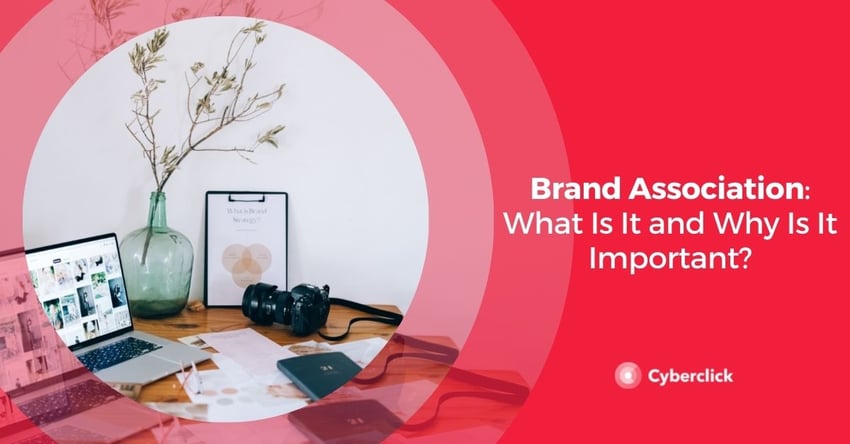Brand association is what consumers think about when they see your brand–the thoughts, concepts, and opinions that your brand elicits in their minds. It can have a strong influence on whether a potential buyer makes a purchase from you, and strategies to encourage positive brand associations should form an integral part of your sales and marketing plan.
In fact, the brand association you develop with your audience can be influential enough to make or break your reputation. This is why it is so vital to understand how your brand is perceived and how each and every interaction can have an impact on your business.
In this post, we will discuss what brand association is and why it is so important. We will also look at how you can create positive brand association and build a solid reputation that helps you stand out from your competitors.

What Is Brand Association?
Brand association is defined as the qualities, traits, emotions, and concepts attached to your brand. In other words, it’s all about how your brand is perceived by your target audience and creating a positive impression. Coupled with brand awareness, it can hello you build solid brand equity.
Think of brand association as the subliminal feelings, thoughts, and ideas that your target market thinks about when they encounter your brand online. What emotional response does your brand elicit from customers? What makes you stand out from your competitors? What image pops into the minds of your target consumers when they think about your brand or see your logo? Ideally, you want to create and reinforce positive associations that encourage potential buyers to choose you over your competitors.
Common categories of brand association include:
-
Attribution Based Brand Association (pricing, packaging, quality, and appearance). For example, IKEA is good value for the money.
-
Attribute-Based Brand Association (dependent on consumer evaluations). For example, Charmin is soft.
-
Celebrity Based Brand Association (when celebrities endorse products and consumers associate them with the brand). A well-known example: Nike and Michael Jordan.
Why Brand Association Is Important
Here are a few of the many benefits of creating positive brand association:
-
Effective brand association stimulates a positive emotional response in consumers.
-
It can help you develop emotional and personal connections between your brand and consumers.
-
It reinforces your brand identity and gives consumers a reason to buy from you.
-
It can create positive feelings and attitudes about your brand.
-
It can make your brand more memorable, especially if your brand is associated with unique qualities that differentiate you from your competitors.
-
Fostering familiarity and reinforcing recognizable attributes can also encourage brand loyalty and long-term brand legacy.
-
Positive brand association can help reassure potential buyers so that they feel confident enough to make a purchase decision.
-
It can help you build a solid, positive reputation.
-
It can be a great way to launch new products or services and generate interest.
How to Create Positive Brand Association
Brand association can be influenced by the following:
-
Brand identity and messaging
-
Brand assets, such as logo and colors
-
Brand loyalty
-
Customer experience
-
Product and service quality
-
Pricing
-
Word of mouth
-
Reputation
-
Advertisements
-
Social media presence
-
Celebrity endorsements
-
Public relations
This is why it is vital to consider all business areas when you build your brand association strategy. Here are a few tips to help you create a positive brand association.
Know Your Target Audience
One of the most important factors when it comes to building a solid brand association is knowing your target audience. Without this information, it is impossible to know how best to communicate and connect with your potential customers. It’s also vital information for creating an effective marketing strategy that reinforces your positive brand association.
Think about the demographics of your typical customer. Research their educational background, their occupation, their concerns, their needs, the challenges they face, and the social media platforms they use. What are their pain points? What do they look for in a brand? Creating a buyer persona – a semi-fictional representation of your ideal or typical customer - can be a great way to better understand your target market.
Once you’ve done this, you should review all your customer touchpoints and think about how you currently interact with your target audience. How do you nurture your community? How do you address unsatisfied customers? How do you manage customer service and customer relationships? All this has an impact on your brand association.
Create a Strong Brand Identity
The next step is to create a strong brand identity. This means understanding your mission, values, brand personality, positioning, and voice. You also need to understand how your brand identity impacts your logo and narrative. What story are you telling consumers about your brand? Does the story elicit positive or negative associations? What about your messaging? Are you effectively communicating the value and unique qualities your brand has to offer? Are you using the right tone?
Generally speaking, if your corporate voice is friendly, warm, and reassuring then this will translate into the concepts, thoughts, and feelings elicited in the minds of consumers when they think about your brand.
Be Consistent
The final tip to keep in mind when you build your brand association is consistency.
Ideally, once you’ve put the work in, researched your target audience and created a strong brand identity that appeals to your potential consumers, you should leave things be. If you frequently make changes to your branding, identity, logo or style of messenger then all you will do is confuse your audience.
Build a strong brand association between your core messages and values and the visual elements of your brand, then stick to it. This is the best way to stand out from the competition and build a solid customer base – a particularly valuable perk in highly competitive, saturated markets.
Licenciada en Publicidad y Relaciones Públicas por la UAB. Digital Marketing Strategist en Cyberclick.
Degree in Advertising and Public Relations from the UAB. Digital Marketing Strategist at Cyberclick.






Leave your comment and join the conversation